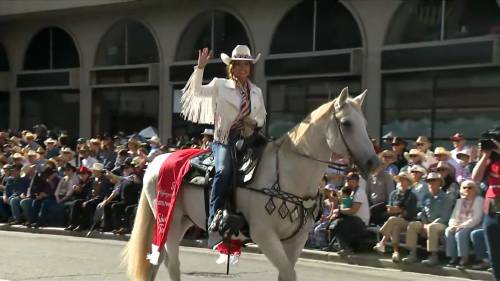I walked down Centre Street around 7 AM yesterday, coffee in hand, watching families stake their claims along the parade route. Children perched on parents’ shoulders pointed excitedly at the barricades being set up, while vendors prepared their carts for what would become a sea of visitors within hours.
“We drove in from Red Deer at 4:30 this morning,” Jennifer Whitecalf told me, spreading a blanket on the sidewalk while her children arranged their cowboy hats. “The parade’s worth it—especially this year.”
The 2025 Calgary Stampede Parade delivered on its promise as the largest yet, drawing an estimated 350,000 spectators under remarkably clear blue skies. What struck me most, wandering between camera crews and parade-goers, was the intentional emphasis on reconciliation woven throughout the procession.
For the third consecutive year, the parade began with a blessing from Treaty 7 First Nations representatives, led by Elder Clarence Wolfleg from Siksika Nation. His presence, alongside dancers from Tsuut’ina, Stoney Nakoda, and other Nations, set a tone that rippled through the subsequent two hours.
“This isn’t just entertainment,” Wolfleg explained when I spoke with him before the parade. “This is recognition of whose land Calgary stands on, whose traditions of horsemanship and connection to these plains came first.”
The Calgary Stampede organization has faced criticism in past years for what some viewed as superficial inclusion of Indigenous cultures. This year’s approach felt more substantive. The Treaty 7 flag carriers proceeded directly ahead of parade marshal Tantoo Cardinal, the acclaimed Métis actress whose five-decade career has broken barriers for Indigenous performers across North America.
Cardinal, elegant on horseback in beaded regalia created specifically for the occasion by Siksika artists, smiled as crowds erupted in applause. “I’ve attended many Stampedes,” she told reporters at Thursday’s marshal reception. “But being asked to lead this parade feels like recognition of how far we’ve come in telling our own stories.”
The parade’s route through downtown Calgary became a river of color and sound, with more than 150 entries ranging from elaborate floats to precision riding teams. The Calgary Police Service mounted unit performed intricate formations that drew gasps from children pressed against barricades. Behind them, the Philippine Association of Calgary’s dancers moved in synchronized patterns despite the morning’s mounting heat.
City data shows this year’s parade featured participants from 27 countries, reflecting Calgary’s increasingly diverse population. According to Statistics Canada’s 2024 municipal census data, nearly 40% of Calgary residents now identify as visible minorities, a demographic shift evident in both parade entries and spectators.
What caught my attention beyond the spectacle itself was how the event has evolved. Calgary Mayor Jyoti Gondek, who rode in the parade alongside other city officials, noted this evolution during a brief exchange. “The Stampede reflects who we are becoming as a city,” she said. “It honors tradition while making space for new voices.”
Those new voices included a first-ever pride-themed float, sponsored by Calgary-based energy company EnCana, featuring LGBTQ+ employees and allies. The float drew mostly cheers, though I noticed scattered tensions in some sections of the crowd.
Beyond the social statements, the parade delivered the classic elements that have made it a Canadian institution for over a century. The famous RCMP Musical Ride performed precision maneuvers on their black horses, red serge uniforms gleaming in the morning sun. The Calgary Stampede Showband’s rendition of “Alberta Bound” had spontaneous sing-alongs breaking out along 6th Avenue.
For many spectators, the parade represents something deeply personal. I met the Patel family, who arrived in Calgary from Gujarat, India, just eight months ago.
“We are learning what it means to be Canadian,” Aarav Patel said, his seven-year-old daughter Priya wearing a newly purchased white cowboy hat. “This celebration feels like it has room for everyone.”
The Calgary Stampede Foundation, which oversees educational initiatives connected to the ten-day festival, has increasingly emphasized this inclusivity. Their 2025 curriculum guide for schools explicitly addresses the complex history of settler-Indigenous relations, while celebrating the agricultural traditions that birthed the event in 1912.
“We’re not trying to sanitize history,” said Erin O’Connor, the Foundation’s education director. “We’re trying to honor it honestly while building something together.”
As the parade concluded with the traditional thundering passage of the heavy horses pulling wagons, I watched people begin to disperse toward Stampede Park or downtown restaurants. The temporary community formed by the parade—grandparents, newcomers, long-time Calgarians, and tourists—exemplified the event’s curious alchemy.
When asked what brings her back year after year, 82-year-old Elaine Kostiuk, who has attended 65 Stampede parades, answered simply: “It reminds me who we are—the good and the complicated. Plus,” she added with a wink, “the mini-donuts haven’t changed since 1960.”
The 2025 Calgary Stampede continues through July 13th, with rodeo events, agricultural exhibitions, and the midway drawing approximately 1.2 million visitors annually according to Tourism Calgary figures.






